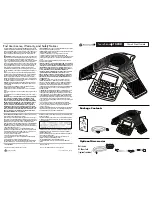
5
Introduction
Criteria for an optimum DECT wireless network
A carefully planned DECT wireless network with adequate coverage is the prerequisite for
operating a telephone system that offers good call quality and sufficient call options for
all subscribers in all buildings and areas belonging to the PABX.
It is difficult to assess the technical wireless conditions of a DECT installation in advance
as they are influenced by many environmental factors. Therefore, the specific circum-
stances on-site must be determined by taking measurements. This produces a reliable
statement about the material required as well as the locations of the wireless units.
Various aspects need to be taken into consideration when planning a DECT wireless net-
work. The following requirements must be considered when deciding how many base
stations are required and where they should be placed:
u
Sufficient DECT wireless coverage of the entire site so that every subscriber can be
reached.
u
Sufficient wireless channels (DECT bandwidth), in particular in "hotspots", to avoid
capacity bottlenecks.
u
Sufficient overlap of cells to enable synchronisation of the base stations and to guar-
antee freedom of movement for subscribers when making calls.
Wireless coverage
The selection of locations where the base stations are to be installed should guarantee
optimum wireless coverage and enable cost-effective wiring.
Optimum wireless coverage is achieved if the required reception quality is delivered at all
points of the wireless network. If costs need to be considered, this should be done with a
minimum number of DECT base stations.
To ensure an interference-free switch of call connections from one cell to another (hando-
ver), there must be an area where good reception is ensured for both base stations. To
achieve this, a minimum quality for reception must be defined.
Wireless cell
Base station
Overlap
VoIPon www.voipon.co.uk [email protected] Tel: +44 (0)1245 808195 Fax: +44 (0)1245 808299








































